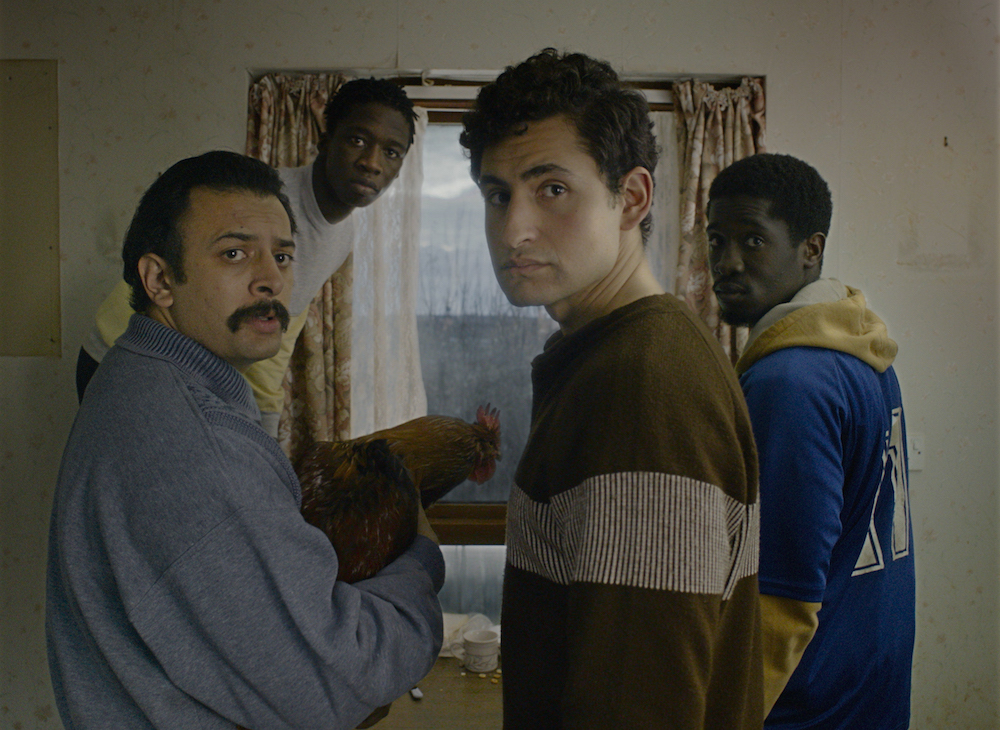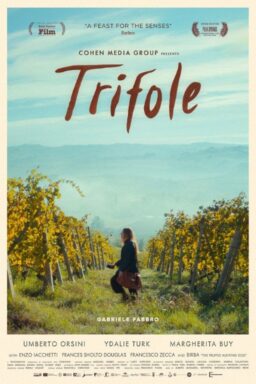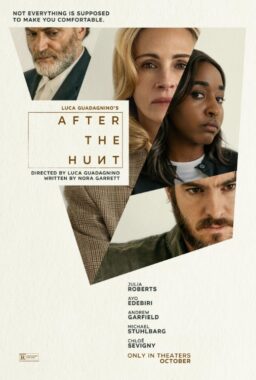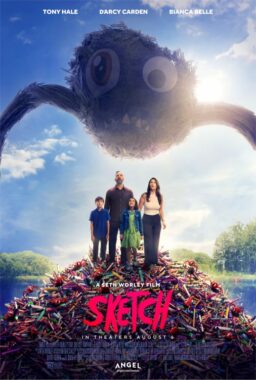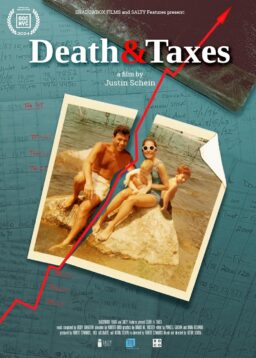A great deal is said about how nailing tone is essential to a tricky script’s execution, but much can be also said for how it’s all designed on set. Take writer/director Ben Sharrock’s second film “Limbo,” which applies the same meticulous character blocking and static camera from his debut “Pikadero” to the story of refugees living in stasis on a Scottish island. The real-life context is tragic and wrenching, but Sharrock’s close-up presentation of these men allows dry humor to peek through, while also depicting the environs as other-worldly and the locals as completely out of touch. In conveying the experiences of refugees like Omar (Amir El-Masry) and his chicken-toting friend Farhad (Vikash Bhai), “Limbo” makes its overt, patient, and symmetrical cinematic style emotionally meaningful, poetically showing the absurdity of this situation for what it is.
Sharrock spoke with RogerEbert.com about the making of the film, developing his own cinematic language, his influence from Middle Eastern directors, and more.
How did you want to take on the story of Syrian refugees, especially with all of your research, and then apply it to your visual style?
The thing was that in the writing, it was hugely challenging. I write the vision of it into the screenplay, so I took a lot of time during the writing of it, and went down a lot of dead ends and had to change my approach. And that’s when there was a huge amount of research in speaking to people who had been through the asylum system and organizations that worked with refugees on a daily basis, and then getting to points and checking the use of humor and checking the use of that absurdity with them. Being like, “Can I use humor here? Is this a good idea?” And throughout that, that came out with a resounding, “Yes, please make a film abut this that uses humor that’s funny and treats the subject with absurdity.” So I think I went through a lot of that with the writing, where I had to build up my own story of authority to tell this story.
But it’s also interesting I suppose, because it’s kind of … I mean Omar is Syrian and a lot of my influences come from Middle Eastern cinema, that’s the root of my filmmaking. And part of that is also the humor; the humor as well is Middle Eastern in that sense. When balancing the tone of it, there was a huge amount of pressure, to be careful with that all the way through the process, from the writing into the rehearsals into the shoot itself. Then it was about spending a long time in post making sure that we were getting that right and doing justice to the subject matter, and doing justice to who these characters represent.

What do you see as realistic or non-realistic about this style of particular blocking and framing? Especially when telling such a human story.
The films that initially made me want to be a filmmaker were Elia Suleiman’s “The Time That Remains” and around the same time “The Band’s Visit” by Eran Kolirin. I think when I saw those two films I was like, “That’s in me? That’s the way that I see films.” I was like, “I’m going to be a film director.” I write my vision as a director into my screenplays. The screenwriting goes hand in hand with the filmmaking, and it’s also interesting because so far with my films, they kind of touch on this stasis I suppose. The characters are in stasis, and that style of filmmaking really lends itself to that stasis because of the static camera. It’s really starting from a point of that being important to the cinematic language of those films, which happened to be really integral to both “Pikadero” and “Limbo.” The characters are in stasis, but the world’s they’re inhabiting are also in stasis; with “Pikadero” it’s the economic crisis and the the world around them is sort of at a stand still, stuck in time, and obviously with “Limbo” they’re in “Limbo.”
In your mind, are these images supposed to be taken literally? Like in “Limbo,” I’m thinking of the shots of Omar at the phone box outside and there’s this meticulous blocking where people are kind patched in the background. What does that mean to you in that way?
Well, for example in the classroom scene, it’s creating that separation between Helga and Boris and the refugees. Literally, that’s happening with the framing of it, and that’s why it’s happening in the Academy frame, because we’re putting refugees in a box. We’re literally putting them in a box, and that kind of idea is related to how Omar is feeling, in the sense of him feeling trapped. But it’s also about how we as the audience see refugees. We put them in a box. Also in the classroom, they’re never in the same frame as Helga and Boris, and that kind of technique is also used with the conversation with the locals, where there’s always separation between them. They’re shot in individual frames.
And then the phone box shot you mentioned at the beginning. I know that when I’m writing it how I want to frame that, and it’s on a wide and have symmetrical composition, and for that to be static. And I know I want to do that because I want it to feel like time had stood still, but also the blocking of the characters in that scene to create the feeling like they’re on another planet, with the plastic ponchos flapping in the wind. So there’s this sort of absurdity created from the composition, and I would say it’s really important to the tone as well, it’s obviously the balance of humor and drama throughout. But it’s a very particularly type of humor, so I’m sort of using the composition and the production design that even the costumes and use of color in the frame to create an undertone of humor, rather than creating that humor using the dialogue. Everything is played very straight and very truthfully, but with the composition and the way we lens it, we’re creating the undertone of humor. That sort of helps us create that balance so then in my head it helps to kind of pivot from comedy to drama. We’re holding that line all the time.
I think about it in a very linguistic way, where I have certain elements that I feel are very engrained in filmmaking. I feel like I try and justify every decision, every shot. And that sort of relates to again the broad idea of cinematic language. I justify things so that I have one foot in the universal cinematic language, but also try to kind of build my own language as well.

When you’re assembling this story in the editing room then, are there drier or funnier cuts? Or is it mostly in the script?
It’s mostly in the script, because it’s pretty economical in terms of shooting. And then I also tend to get with the performance of those scenes, and not for everything, sometimes there were maybe sightly different things going on in the classroom scenes with Helga and Boris. But what I tend to do, is we know what we’re wanting to achieve in the scene, so we’re working toward that. So when we’re going through the takes, we’re not like, “Do one happy take, do one sad take. Do one funny take.” We’re going with, “This is what we’re trying to get from this scene, this is what we’re trying to achieve.” With each take we’re working on getting closer and closer to doing that.
And that’s the thing, I’ve only ever worked on my own films. I was talking to someone recently and they’re like, an actor working on another film, and they were saying that the director was asking them to do it differently on every single take. Like an entirely different performance. I thought that was really interesting, but does [the director] not know what he wants to achieve in a scene when you’re just trying everything out? I get it. But in general, me and the actors and the team, we’re all very clear on what we want to achieve and are working toward that the whole time.
It’s funny you mention range like that, because your actors are, in contrast to that story, often in close-up, working with very specific expressions. How meticulous do you have to be when getting performances with this tone?
I would say that on one hand, very meticulous. Because it’s often going from wide to close as well, so on the close-ups, we’re also inches, actually at times centimeters from the actor’s face. And on certain shots we would have actors faces inside the matte box. So their movements are sort of minuscule, it’s being very careful over the performance, any kind of movement is going to look huge in the way that we’re shooting it. And obviously, the blocking is very particular as well. I always block to camera and take a long time with blocking before we shoot. But then at the same time, it’s kind of meticulous in that sense, but I also think that it’s not restrictive for the actors.
The other side of it is that even though there’s a particular blocking, there’s also sort of room to one, change the performance on the wide shots because you can afford to use a bigger performance on the wide shots and use movement in a different way, and two, then bring that performance really inside, when we’re on the close-ups and close with the camera but also having the static frame, setting the scene. So the actors can work with the frame: they know what the frame is, and they can use the blocking and have the freedom to also experiment with that. It’s a very collaborative process with the actors as well. The rehearsal period is really important to work on the script and the characters and talk through everything, but also work on the style of performance, because that’s quite particular. But to also build a relationship of trust with the actors we know what we want, and we have the freedom to try this or so this. It is meticulous, but there’s something freeing about having that static camera and that structure.
“Limbo” is now playing in theaters.

